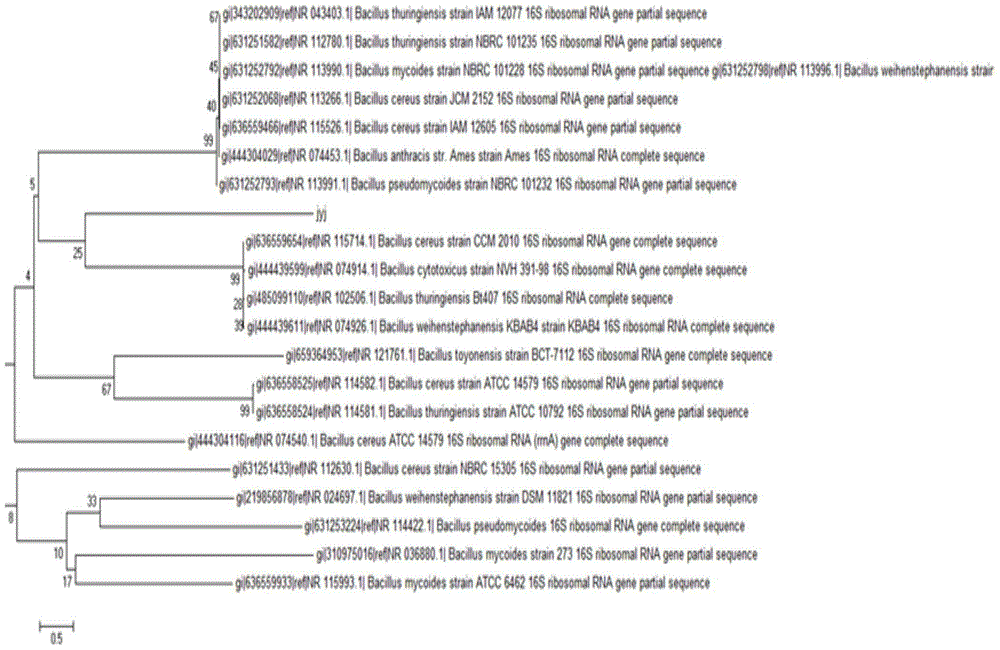Method for repairing cadmium-polluted soil by combination of microorganisms and plants
A cadmium-contaminated soil and joint restoration technology is applied in the field of joint restoration of cadmium-contaminated soil by microbial inoculants and plants, which can solve problems such as strong changes and achieve the effects of strong adaptability, broad application prospects and low cost.
- Summary
- Abstract
- Description
- Claims
- Application Information
AI Technical Summary
Problems solved by technology
Method used
Image
Examples
Embodiment 1
[0029] Example 1: Screening, identification and biological characteristics analysis of Bacillus cereus JYJ
[0030] 1) Soil sample source: Activated sludge from an electroplating sludge factory in Nanjing
[0031] 2) Strain screening: Take 1g of activated sludge and add it to 10ml of liquid LB medium (peptone 10g / L, sodium chloride 10g / L, yeast powder 5g / L.) Enrichment culture, culture conditions 37 ℃ 180r / min, cultivated for 24 hours; take 1ml of the enriched culture solution and inoculate it in the fresh liquid medium containing 100mg / L cadmium, culture at 37°C and 180r / min; / L metal ion liquid medium, increase the metal ion concentration step by step. Then use the inoculation loop to take the culture solution with the highest tolerance concentration and inoculate it on the solid plate containing 100mg / L cadmium ion, and incubate at 37℃ for 24h. According to the colony morphology on the plate, single colonies were picked and inoculated into the cadmium ion selective mediu...
Embodiment 2
[0038] A method for microorganism-plant joint restoration of cadmium-contaminated soil, in which ryegrass seeds are evenly sprinkled into cadmium-containing soil, and the seeding rate is 2-4g / m 2, and the upper part is covered with 1cm of soil. The suitable temperature of ryegrass in cadmium-contaminated soil is 15-38°C. Water regularly to keep the soil water content at 60-80% of the maximum water holding capacity in the field. After 10-20 days, when the plants germinate and grow, they will grow into the ryegrass root soil Add microbial compound bacterial agent, the dosage of microbial compound bacterial agent in soil is 0.3~1L / m 2 Utilize the absorption of ryegrass to cadmium and the intensification of microbial compound bacterial agent to jointly remove cadmium in soil; Bacillus subtilis) ATCC23857 and Shewanella (Shewanella) ATCC700550 are mixed according to the wet bacteria weight ratio of 1-10:1:1.
Embodiment 3
[0039] Example 3: The enrichment ability of cadmium in soil by different combinations of ryegrass and microbial agents
[0040] In the experiment, plastic pots with a diameter of about 10 cm were used, and each pot was filled with about 1 kg of soil. After the test soil was air-dried, it was passed through a 2 mm sieve. The heavy metal cadmium was added into the pot in the form of a solution and mixed evenly. The amount of water is 80% of the maximum water holding capacity in the field. After a week of natural balance, ryegrass seeds are sprinkled in the pots, and the seeding rate is 2g / m 2 , the upper part is covered with 1cm of soil, and after 10 days of plant growth, the experiment of each treatment group is started, and the amount of the experimental group with microbial agent is 0.4L / m 2 .
[0041] in,
[0042] Group 1 consisted of only ryegrass without any added microorganisms.
[0043] The second group is ryegrass + Bacillus cereus 0.4L / m 2 .
[0044] The third gro...
PUM
 Login to View More
Login to View More Abstract
Description
Claims
Application Information
 Login to View More
Login to View More - R&D
- Intellectual Property
- Life Sciences
- Materials
- Tech Scout
- Unparalleled Data Quality
- Higher Quality Content
- 60% Fewer Hallucinations
Browse by: Latest US Patents, China's latest patents, Technical Efficacy Thesaurus, Application Domain, Technology Topic, Popular Technical Reports.
© 2025 PatSnap. All rights reserved.Legal|Privacy policy|Modern Slavery Act Transparency Statement|Sitemap|About US| Contact US: help@patsnap.com



